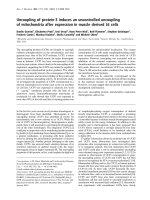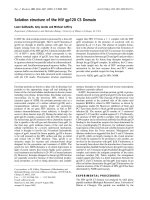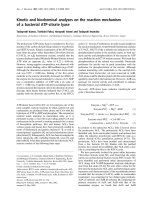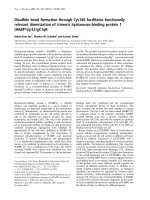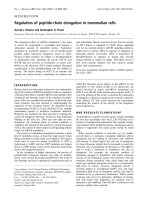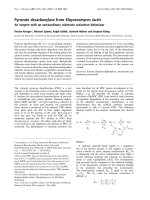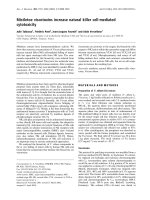Báo cáo y học: " Fibrinogen decreases cardiomyocyte contractility through an ICAM-1-dependent mechanism" pptx
Bạn đang xem bản rút gọn của tài liệu. Xem và tải ngay bản đầy đủ của tài liệu tại đây (1.2 MB, 10 trang )
Open Access
Available online />Page 1 of 10
(page number not for citation purposes)
Vol 12 No 1
Research
Fibrinogen decreases cardiomyocyte contractility through an
ICAM-1-dependent mechanism
John H Boyd, Edmond H Chau, Chiho Tokunanga, Ryon M Bateman, Greg Haljan, Ehsan Y Davani,
Yinjin Wang and Keith R Walley
University of British Columbia Critical Care Research Laboratories, St. Paul's Hospital, 1081 Burrard Street, Vancouver, BC, V6Z 1Y6, Canada
Corresponding author: John H Boyd,
Received: 18 Jul 2007 Revisions requested: 5 Sep 2007 Revisions received: 14 Oct 2007 Accepted: 3 Jan 2008 Published: 3 Jan 2008
Critical Care 2008, 12:R2 (doi:10.1186/cc6213)
This article is online at: />© 2008 Boyd et al.; licensee BioMed Central Ltd.
This is an open access article distributed under the terms of the Creative Commons Attribution License ( />),
which permits unrestricted use, distribution, and reproduction in any medium, provided the original work is properly cited.
Abstract
Introduction Cardiomyocytes exposed to inflammatory
processes express intracellular adhesion molecule-1 (ICAM-1).
We investigated whether fibrinogen and fibrinogen degradation
products, including D-dimer, could alter cardiomyocyte
contractile function through interaction with ICAM-1 found on
inflamed cardiomyocytes.
Methods In vivo, rats were injected with endotoxin to model
systemic inflammation, whereas isolated rat cardiomyocytes
were treated with tumor necrosis factor-alpha to model the
inflammatory environment seen following exposure to bacterial
products such as lipopolysaccharide.
Results In vivo, endotoxin administration profoundly decreased
cardiac contractile function associated with a large increase in
intracardiac ICAM-1 and perivascular fibrinogen. Confocal
microscopy with double-staining of isolated rat cardiomyocytes
demonstrated colocalization of ICAM-1 and fibrinogen. This
interaction was disrupted through pre-treatment of the cells with
an ICAM-1-blocking antibody. Functionally, isolated rat
cardiomyocyte preparations exhibited decreased fractional
shortening when incubated with fibrinogen, and through the use
of synthetic peptides, we determined that residues 117–133 of
the fibrinogen gamma chain are responsible for this interaction
with ICAM-1. Despite having crosslinked gamma chains, D-
dimer retained the ability to decrease cardiomyocyte
contractility.
Conclusion Site 117–133 of the fibrinogen gamma chain is
able to depress cardiomyocyte contractility through binding
ICAM-1.
Introduction
Both local and systemic inflammation impair cardiac contrac-
tility, although the precise mechanism behind this is still
unclear [1-3]. It is now recognized that high levels of inflamma-
tory biomarkers such as C-reactive protein and D-dimer are
associated with an increased incidence of, and worse progno-
sis for, cardiovascular disease [4-8]. However, whether these
molecules are simply markers of the inflammatory process or
might actually play a causative role in the resultant organ dys-
function is not known. We previously reported a novel two-
step regulatory mechanism of cardiomyocyte contractility
whereby systemic inflammation induces cardiomyocyte-
expressed intracellular adhesion molecule-1 (ICAM-1), whose
subsequent ligation results in decreased contractility by sign-
aling via the cytoskeleton [9]. While studies using cardiomyo-
cyte/leukocyte co-culturing methods demonstrate that
activated leukocytes can bind to ICAM-1 with a resultant
decrease in myocardial contractility [9-11], we and others
have noted a paucity of intramyocardial leukocytes in whole
animal models of inflammation [12,13]. Therefore, we postu-
lated that in the more complex environment of an in vivo model,
ICAM-1 ligands other than the CD11/CD18 receptors found
on activated leukocytes [14-16] play a greater role in ICAM-1-
dependent decreases in cardiomyocyte contractility.
Fibrinogen, a 340-kDa plasma glycoprotein with a physiologi-
cal plasma concentration of 1.5 to 4.5 g/L, as well as its
related protein fragments D-dimer and other fibrinogen degra-
BSA = bovine serum albumin; EDV = end diastolic volume; E
es
= end-systolic elastance; EF = ejection fraction; ELISA = enzyme-linked immunosorb-
ent assay; E
max
= maximal end-systolic elastance; FDP = fibrinogen degradation product; FITC = fluorescein isothiocyanate; ICAM-1 = intracellular
adhesion molecule-1; Ig = immunoglobulin; LAD = left anterior descending; LPS = lipopolysaccharide; PBS = phosphate-buffered saline; TNF-α =
tumor necrosis factor-alpha; vWF = von Willebrand factor; XL = crosslinking.
Critical Care Vol 12 No 1 Boyd et al.
Page 2 of 10
(page number not for citation purposes)
dation products (FDPs) represent potential ICAM-1-binding
myocardial depressant substances. The amino acid sequence
117–133 of fibrinogen gamma chain (fg-γ-117–133) binds to
the amino acid sequence 8–22 (ICAM-1-8–22) within the first
immunoglobulin (Ig) domain of ICAM-1 [17]. The functional
role of the fibrinogen-ICAM-1 interaction includes adhesion of
leukocytes to endothelial cells [18,19], leukocyte transmigra-
tion [20], and promotion of endothelial cell survival [21]. Inter-
estingly, fibrinogen-ICAM-1 ligation leads to cytoskeleton-
dependent ERK1/2 (extracellular signal-regulated kinase-1/2)
phosphorylation in endothelial cells [22]. In view of our previ-
ous observation in cardiomyocytes that ICAM-1 ligation by leu-
kocytes reduces contractility via focal adhesion kinase
phosphorylation at the cytoskeleton [9], fibrinogen-ICAM-1
ligation ultimately could lead to alteration in cardiomyocyte
contractile function. As fragments of polymerized fibrinogen
such as D-dimer are markedly elevated in most inflammatory
states [4-8], it is of particular interest to determine whether
these molecules are able to influence cardiac physiology
through interaction with ICAM-1.
The goal of our study, therefore, was to determine whether
exposure to fibrinogen and FDPs altered the contractile func-
tion of cardiomyocytes. To simulate systemic inflammation,
rats were injected with endotoxin, and through immunohisto-
chemistry, we confirmed an increase in both cardiomyocyte-
expressed ICAM-1 as well as increased intramyocardial fibrin-
ogen deposition. In isolated cardiomyocytes exposed to an
inflammatory environment, we established the specificity of the
fibrinogen-ICAM-1 interaction and went on to determine the
active site on fibrinogen responsible for ICAM-1-mediated
alterations in contractility.
Materials and methods
This study was approved by the University of British Columbia
Animal Care Committee and adheres to the Canadian and
National Institutes of Health guidelines for animal
experimentation.
In vivo experimental models
For the endotoxin model of inflammation, male Sprague-Daw-
ley rats 350 to 450 g in weight were injected intraperitoneally
with lipopolysaccharide (LPS) (10 mg/kg) or vehicle control
(normal saline). The LPS dosage was selected as a midrange
dosage of endotoxemic models that result in a hemodynamic
effect [23,24]. The heart was excised 6 hours after injection,
embedded in Optimal Cutting Temperature compound (Elec-
tron Microscopy Sciences, Hatfield, PA, USA), frozen in dry-
ice-chilled isopentane, and stored at -80°C.
Measurement of left ventricular contractility and cardiac
function
Left ventricular contractility and other measures of ventricular
function were determined from pressure-volume measure-
ments using Pressure-Volume Analysis software (PVAN 2.9;
Millar Instruments Inc., Houston, TX, USA). Six to ten pressure-
volume loops during a vena cava occlusion were sampled and
used to measure end-systolic elastance (E
es
), which is the
slope of the end-systolic pressure-volume relationship rela-
tively insensitive to changes in preload and afterload [25]. E
max
is defined as the maximal E
es
. The volume axis intercept, Vd,
was considered zero volume for the steady-state measure-
ments. Pressure-volume loops measured during steady-state
conditions were used to measure the maximum rate of change
of intraventricular pressure during isovolumic systole divided
by end diastolic volume (EDV), (dP/dt
max
)/EDV, which is a sen-
sitive isovolumic phase measure of left ventricular contractility
[26], as well as to calculate ejection fraction (EF). End-systolic
pressure during steady state was used as a measure of sys-
temic arterial pressure afterload.
Immunofluorescent imaging with quantification
Frozen heart sections (6 μm) were acetone-fixed and incu-
bated with universal blocking agent (DakoCytomation, Glos-
trup, Denmark). Fibrinogen and von Willebrand factor (vWF),
a marker for the endothelium, were stained together to assess
whether infiltration of fibrinogen into the myocardium
occurred. Sections were incubated with 1:20 fluorescein iso-
thiocyanate (FITC)-conjugated goat anti-mouse fibrinogen
(Nordic Immunological Laboratories, Tilburg, The Netherlands)
and 1:200 rabbit anti-mouse vWF (DakoCytomation) primary
antibody and then labeled with Alexa Fluor 594 goat anti-rab-
bit antibody (Invitrogen Corporation, Carlsbad, CA, USA).
Nuclei were stained with the Hoechst stain (Invitrogen Corpo-
ration). Control sections were incubated with FITC-conju-
gated non-specific goat IgG (Santa Cruz Biotechnology, Inc.,
Santa Cruz, CA, USA) and non-specific rabbit IgG (DakoCy-
tomation) and processed in identical conditions.
Immunofluorescent ICAM-1 staining was carried out by incu-
bating sections with 1:500 mouse anti-rat ICAM-1 monoclonal
antibody 1A29 (BD Biosciences, San Jose, CA, USA) and
then with Alexa Fluor 594-labeled goat anti-mouse antibody
(Invitrogen Corporation). Control sections were incubated
with non-specific mouse IgG (Invitrogen Corporation). After
drying, the slides were mounted with DABCO (1,4-diazabicy-
clo[2.2.2]octane) to prevent photobleaching.
Images were captured using a laser scanning confocal micro-
scope with a 63× water immersion lens (Leica SP2; Leica,
Wetzler, Germany). Samples were imaged using fluorescence
with wavelength excitations and emissions of 488 nm and 495
to 580 nm (respectively) for fibrinogen and 594 nm and 600
to 700 nm (respectively) for vWF and ICAM-1. The scan for-
mat was 512 × 512 pixels. Image capturing was performed
sequentially using a three-frame average. All imaging was per-
formed under identical microscope settings (for example, laser
intensity and photomultiplier tube gain).
Available online />Page 3 of 10
(page number not for citation purposes)
Cross-sections of 15 randomly selected blood vessels, identi-
fied via vWF staining, were imaged. Two ellipses were traced
around each vessel: a small ellipse positioned closely along
the vessel boundary and a large ellipse with proportional major
and minor axes but three times the area of the small ellipse.
Fibrinogen staining present in the annulus between the two
ellipses was identified as perivascular fibrinogen. The sum flu-
orescence intensity per annulus area was measured using the
Leica software.
To measure myocardial ICAM-1 expression, heart sections
from the endotoxemic and control groups were imaged as
described above and fluorescent intensity measures were
taken using traced field areas containing myocardial tissue.
The sum fluorescence intensity per unit area was measured
using the Leica software.
Isolation of rat ventricular myocytes
Male Sprague-Dawley rats were injected with heparin and
anesthetized using isofluorane. The heart was excised,
mounted on a modified Langendorff apparatus, and digested
with 281 U/mL collagenase (Worthington Biochemical Corpo-
ration, Lakewood, NJ, USA). After digestion, the cells were
resuspended in modified Eagle's medium containing increas-
ing Ca
2+
concentrations (200 μM, 500 μM, and 1 mM). Five
hundred thousand cells in M199 with bovine serum albumin
(BSA) were loaded into a laminin-coated Petri dish 6 cm in
diameter (BD Biosciences) and the cardiomyocytes were
incubated for 12 hours to allow them to become relatively qui-
escent. After 24 hours, cells were considered viable if they
demonstrated a characteristic rod shape without cytoplasmic
blebbing.
Measurement of cardiomyocyte fractional shortening
Cells were paced at 1 Hz using a Grass S48 stimulator
(Grass-Telefactor, Warwick, RI, USA) with a voltage set at
120% of the threshold capture voltage. Images were captured
using a Myocam video camera (IonOptix Corporation, Milton,
MA, USA) and analyzed using an IonOptix Softedge detection
package (IonOptix Corporation). Fractional shortening was
calculated as the difference between diastolic and systolic
lengths, divided by diastolic length.
Coating of fibrinogen to polystyrene beads
Polystyrene beads 8 μm in diameter (Bangs Laboratories, Inc.,
Fishers, IN, USA) were washed twice with acetate buffer (pH
5.4). Beads were mixed with rat fibrinogen (Enzyme Research
Laboratories, South Bend, IN, USA) at a concentration of
300,000 beads per microgram of fibrinogen in a 500-μL
Eppendorf tube. A micromagnetic stir bar was placed in the
tube, and the mixture was gently stirred for 2 hours at room
temperature. The beads were then washed three times with
fresh acetate buffer. Clumps of fibrinogen-coated beads were
broken apart by passing them through a syringe with a 27.5-
guage needle.
ICAM-1 peptide-fibrinogen binding assay
Ninety-six-well Corning Costar 9018 enzyme-linked immuno-
sorbent assay (ELISA) plates (eBioscience, Inc., San Diego,
CA, USA) were coated for 2 hours at room temperature with
fibrinogen concentrations ranging from 0.01 to 100 nM in
bicarbonate/carbonate coating buffer (3.03 g of Na
2
CO
3
, 6.0
g of NaHCO
3
per 1,000 mL of distilled water) (pH 9.6). Wells
were washed with phosphate-buffered saline (PBS) and then
blocked overnight with 1% BSA. One hundred micromolar
biotinylated ICAM-1 (8–22) sequence EAFLPRGGS-
VQVNCS or biotinylated scrambled peptide sequence SCN-
VQVSGGRPLFAE (University of British Columbia Peptide
Facility, Vancouver, BC, Canada) was then added to the wells
and incubated for 2 hours at room temperature before wash-
ing three times with PBS. HRP-linked anti-biotin antibody (1
μg/mL) (Invitrogen Corporation) was then added and incu-
bated for 2 hours, followed by three washes. One hundred
microliters of ABTS (2,2'-azino-di(3-ethylbenzthiazoline sul-
fonate) solution (Chemicon International, Temecula, CA, USA)
was added to each well and incubated for 60 minutes.
Absorbance values were measured at 405 nm and at 492 nm
for reference.
Incubations
Twenty-four hours after cardiomyocyte isolation, cells were
activated with tumor necrosis factor-alpha (TNF-α) (20 ng/mL)
for 4 hours to upregulate ICAM-1 expression [9]. In studies
using fibrinogen-coated beads, 25,000 beads were added to
cells in laminin-coated 96-well plates (500 cells per well). A
bead that moved with the contracting cardiomyocyte and
maintained a contact relative location on the membrane during
contraction was considered to be adherent. In studies using
rat fibrinogen (Enzyme Research Laboratories), human fibrino-
gen, D-dimer fragments D and E (HYPHEN BioMed, Neuville-
sur-Oise, France), and fibrinogen gamma chain (AnaSpec,
Inc., San Jose, CA, USA) cells were incubated at concentra-
tions of 0.03 μM, 0.1 μM, 0.3 μM, and 1 μM, respectively, for
4 hours at 37°C. After 4 hours at 37°C, cardiomyocyte frac-
tional shortening was measured as described above.
In studies using the ICAM-1 (8–22) sequence EAFLPRGGS-
VQVNCS or scrambled peptide sequence SCNVQVSG-
GRPLFAE (University of British Columbia Peptide Facility), 1
μM rat fibrinogen and 100 μM ICAM-1 (8–22) or scrambled
peptide were mixed and incubated for 4 hours at 37°C prior to
incubation with cardiomyocytes as described above. In stud-
ies using anti-ICAM-1-blocking monoclonal antibody 1A29
(BD Biosciences), the antibody was added to cardiomyocytes
at a concentration of 200 ng/mL 4 hours prior to the addition
of fibrinogen.
Colocalization of ICAM-1 with fibrinogen
Upon TNF-α activation, cardiomyocytes were co-cultured with
Oregon Green-labeled fibrinogen (Invitrogen Corporation) for
4 hours. They were then fixed with 3% paraformaldehyde for
Critical Care Vol 12 No 1 Boyd et al.
Page 4 of 10
(page number not for citation purposes)
20 minutes and blocked with universal blocking agent. Immun-
ofluorescent ICAM-1 staining was carried out by incubating
the cardiomyocytes with 1:500 mouse anti-rat ICAM-1 anti-
body (BD Biosciences) followed by Alexa Fluor 594-labeled
goat anti-mouse antibody. The cardiomyocytes were examined
using a confocal microscope (Leica) as described in the pre-
vious section. The scan format was 1,024 × 1,024 pixels, and
2× zoom was applied.
Statistical analysis
All data are expressed as mean ± standard error. For each
experimental condition and time point, at least four independ-
ent replicate analyses were performed, unless otherwise
noted. Differences between groups were tested using a one-
way analysis of variance and the post hoc Bonferroni test to
identify specific differences between groups. Differences
were considered significant for P values of less than 0.05.
Results
Systemic inflammation depresses cardiac contractility
and is associated with intracardiac extravasation of
fibrinogen and increased expression of ICAM-1 by
cardiomyocytes
We determined whether endotoxin would create an environ-
ment within the heart which would allow ICAM-1 expressed on
cardiomyocytes to interact with extravasated fibrinogen and
whether this would be associated with alterations in cardiac
contractility. Six hours after LPS injection, the endotoxemic
group of rats exhibited decreased left ventricular contractility
compared with the saline-treated controls (Figure 1). Cardiac
cycle pressure-volume loops using mean data clearly demon-
strate an LPS-induced rightward shift along the volume axis.
This shift reflects left ventricular dilation represented by
increased EDV, maintenance of stroke volume (SV), and
resultant marked reduction of left ventricular EF (EF = SV/
EDV) (Figure 1 and Table 1). The preload-independent E
max
is
dramatically decreased in LPS-treated versus saline-treated
rats, whereas (dP/dT)/EDV reflects isovolemic contractility
and is also depressed with LPS (Table 1). Immunostaining of
heart tissue from these rats demonstrated a dramatic increase
in both intramyocardial ICAM-1 expression and perivascular
fibrinogen in the myocardium of LPS-treated rats (Figure 2a,b).
Image quantification demonstrated a 5.5 ± 1.6-fold increase in
ICAM-1 expression and a 2.1 ± 0.6-fold increase in perivascu-
lar fibrinogen in the myocardium of LPS-treated rats (Figure
2c).
ICAM-1 expressed on activated isolated cardiomyocytes
specifically binds to fibrinogen
By means of confocal microscopy, ICAM-1 was found to be
present on the cell surface of TNF-α-activated cardiomyo-
cytes. Co-immunostaining with fluorescently labeled fibrino-
gen demonstrated a high degree of colocalization (Figure 3a),
supporting previous reports of interaction between these two
molecules [17,21]. To confirm that fibrinogen specifically
bound ICAM-1, we pre-treated isolated cardiomyocytes with
either with an ICAM-1-blocking antibody or non-specific IgG.
Compared with the IgG control group, cardiomyocytes treated
with blocking antibody to ICAM-1 exhibited significantly lower
adherence to fibrinogen-coated beads (Figure 3b). ICAM-1 is
known to interact with fibrinogen via ICAM-1 peptides 8–22.
To confirm this specific interaction between ICAM-1 and
fibrinogen, we performed an ELISA binding assay using immo-
bilized fibrinogen incubated with biotinylated ICAM-1 (8–22)
peptide. In dose-finding experiments, as expected with recep-
tor-ligand binding, there is a dose-response curve that reaches
saturation at a fibrinogen concentration of 100 μM (Figure 4a).
When group mean absorbance data are taken at this plateau
fibrinogen concentration of 100 μM, there is a large increase
in ICAM-1 (8–22) peptide binding with fibrinogen compared
with scrambled peptide (Figure 4b). Thus, fibrinogen specifi-
cally binds to ICAM-1 through interaction with ICAM-1 pep-
tides 8–22.
Fibrinogen mediates decreased cardiomyocyte
contractility via an ICAM-1-dependent mechanism
We next examined whether ICAM-1 ligation by fibrinogen
alters cardiomyocyte contractility. In one series of experiments,
isolated cardiomyocytes were pre-treated with either ICAM-1-
blocking antibody or isotype control antibody before adding
fibrinogen-coated polystyrene beads. Whereas cardiomyo-
cytes pre-treated with isotype control antibody demonstrated
a dose-dependent decrease in contractility upon exposure to
fibrinogen-coated beads, cardiomyocytes pre-treated with
ICAM-1-blocking antibody demonstrated no reduction in con-
tractility (Figure 5). To verify that this interaction is mediated
Table 1
Hemodynamic data from endotoxemic and control animals
Treatment Heart rate (beats per minute) Systolic pressure (mm Hg) Ejection fraction (percentage) (dP/dT)/EDV E
max
LPS 392 ± 152 108 ± 8 38 ± 2 44 ± 3 2.5 ± 0.4
Control
a
313 ± 30 112 ± 6 52 ± 8 121 ± 11 7.7 ± 0.6
P = NS P = NS P < 0.05 P < 0.05 P < 0.05
a
Saline-treated rats. dP, derivative of pressure; dT, derivative of time; EDV, end diastolic volume; E
max
, maximal end-systolic elastance; LPS,
lipopolysaccharide-treated rats; NS, not significant.
Available online />Page 5 of 10
(page number not for citation purposes)
specifically via the ICAM-1 (8–22) fibrinogen binding site, we
performed a competitive assay in which a peptide containing
the ICAM-1 (8–22) fibrinogen binding site was pre-incubated
with soluble fibrinogen before addition of this mixture to
activated isolated cardiomyocytes. Pre-incubation of the fibrin-
ogen with excess ICAM-1 (8–22) peptide abolished the fibrin-
ogen-mediated decrease in cardiomyocyte contractility,
whereas pre-incubation of fibrinogen with a 'scrambled' pep-
tide containing the same residues showed no such effect (Fig-
ure 6).
Fibrinogen chain D mediates decreased cardiomyocyte
contractility
Fibrinogen is composed of three major subunits, a central E
chain linked to two D chains (Figure 7a). The smaller gamma
chain is always found associated with the D chain and thus is
not generally considered to be a distinct subunit. To determine
whether the fibrinogen-mediated contractile dysfunction
results from interaction of ICAM-1 with the intact whole mole-
cule or whether a single chain contains the binding site, cardi-
omyocytes were incubated with whole fibrinogen, fibrinogen
chain D, or fibrinogen chain E. There was a significant
decrease in cardiomyocyte contractility following incubation
with whole fibrinogen and fibrinogen chain D, but no effect
was seen with fibrinogen chain E (Figure 7b).
Figure 1
LPS decreases cardiac contractilityLPS decreases cardiac contractility. Cardiac cycle pressure-volume
loops obtained 6 hours after intraperitoneal injection of lipopolysaccha-
ride (LPS) or saline into rats. Acquired with group mean data, the
curves demonstrate an LPS-induced increased end diastolic volume
(EDV), maintenance of stroke volume (SV), and therefore a marked
reduction of left ventricular ejection fraction (SV/EDV). E
es
, end-systolic
elastance.
Figure 2
LPS increases intracardiac ICAM-1 and perivascular fibrinogenLPS increases intracardiac ICAM-1 and perivascular fibrinogen. (a)
Frozen cardiac sections from lipopolysaccharide (LPS)-treated and
saline-treated rats demonstrate that intracardiac intracellular adhesion
molecule-1 (ICAM-1) (red) is dramatically increased in the former. (b)
Fibrinogen (green) was greatly increased outside the endothelium (von
Willebrand factor labeled red) in the LPS group compared with rats
treated with saline. (c) Group mean data of the fold increases in myo-
cardial ICAM-1 expression and perivascular fibrinogen deposition in
LPS-treated versus saline-treated animals. *p < 0.05 versus saline.
Critical Care Vol 12 No 1 Boyd et al.
Page 6 of 10
(page number not for citation purposes)
Amino acid sequence 117–133 of the fibrinogen gamma
chain is the active site, and the crosslinked gamma chains
of D-dimer retain the ability to interact with ICAM-1
We next determined whether the ICAM-1 binding gamma
chain site 117–133 [17] of the D chain (Figure 8a) was
responsible for the observed contractile dysfunction. Further-
more, as dimerization of fibrinogen chain D (commonly known
as D-dimer) is accomplished in part via crosslinking the XL
sites of the gamma chain (Figure 8a,b) [27], we tested
whether dimerization resulted in attenuation of the ICAM-1-
mediated effect. The gamma peptide 117–133 resulted in a
significant reduction in fractional shortening compared with
control, whereas scrambled peptide had no effect (Figure 8c).
Incubation with D-dimer also resulted in a significant reduction
in fractional shortening (Figure 8c), demonstrating that the
functional site 117–133 remains active despite crosslinking of
gamma chains.
Discussion
In this study, we propose a novel mechanism linking two phe-
nomena that occur as a result of inflammation: dysregulation of
the coagulation cascade and myocardial dysfunction. The key
finding reported is that amino acid sequence 117–133 of the
fibrinogen gamma chain decreases cardiomyocyte contractil-
ity through binding ICAM-1. Of great interest to clinicians is
that D-dimer, a product of fibrinogen polymerization and sub-
sequent digestion which includes 117–133 of the gamma
chain, in addition to its important role in diagnosis of throm-
boembolism, can decrease cardiomyocyte contractility.
It has long been recognized that seemingly disparate causes
of local or systemic inflammation, such as ischemia reper-
fusion, inflammatory cardiomyopathy, orthotopic heart trans-
plant rejection, or sepsis [1-3], all culminate in myocardial
dysfunction. While each disorder undoubtedly poses unique
challenges to the maintenance of myocardial homeostasis,
there could be a factor that is common to all. Endothelial dam-
age with subsequent capillary leakage represents a final com-
mon pathway of inflammatory disorders [28]. Increased
permeability of the endothelium leads to a shift of circulating
elements from the plasma into the organs. Should this fluid flux
contain circulating substances capable of depressing myocar-
dial contractility, this may be the link between myocardial dys-
function and inflammatory states. This depressant not only
must reach the cardiac myocytes but must have a receptor
capable of mediating changes in contractility. We have previ-
Figure 3
Fibrinogen binds specifically to cardiomyocyte ICAM-1Fibrinogen binds specifically to cardiomyocyte ICAM-1. Colocalization of fibrinogen and cardiomyocyte intracellular adhesion molecule-1 (ICAM-
1). (a) Isolated cardiomyocytes were incubated with Oregon Green-labeled fibrinogen (green) and fluorescently stained for ICAM-1 (red). A multi-
photon dual-excitation image of the contour of the cell of interest is shown. By means of an overlay of images, strong colocalization of fibrinogen and
ICAM-1 was indicated by a yellow color. (b) A representative image of a rat cardiomyocyte with adherent fibrinogen-coated polystyrene beads (white
arrows) is shown to the left of the graph. The specificity of the ICAM-1-fibrinogen interaction is demonstrated as anti-ICAM-1 antibody pre-treatment
results in significantly less fibrinogen-coated polystyrene beads adherent to the cardiomyocytes (*p < 0.05 versus control). Ab, antibody; CL, con-
trol; IgG, immunoglobulin G.
Available online />Page 7 of 10
(page number not for citation purposes)
ously shown that ICAM-1 expressed on cardiomyocytes is
induced by inflammatory mediators and, upon activation, is
capable of decreasing cardiomyocyte contractility [9,13].
Any circulating ICAM-1 ligands could be candidates for caus-
ing myocardial dysfunction provided that they permeate the
heart. CD11a/CD18 (LFA-1) and Cd11b/CD18 (Mac-1)
expressed on the surface of polymorphonuclear leukocytes
are ICAM-1 ligands capable of reducing myocyte contractility
in vitro [11] and have been proposed to be the link between
inflammation and cardiac dysfunction. However, we and oth-
ers have noted a striking paucity of intramyocardial leukocytes
in whole animal models of inflammation [12,13]. Fibrinogen, as
well as its related protein fragments D-dimer and other FDPs,
represents potential ICAM-1 binding myocardial depressant
substances. Through both human epidemiologic data and
basic science, fibrinogen and FDPs satisfy two major criteria
for causality. Clinically, not only are fibrinogen and D-dimer
markedly increased in inflammatory disorders, but their levels
are inversely correlated with favorable outcome [4-8]. As for
biologic plausibility, the amino acid sequence 117–133 of
fibrinogen gamma chain (fg-γ-117–133) is capable of binding
the amino acid sequence 8–22 (ICAM-1-8–22) within the first
Ig domain of ICAM-1 [17]. While the fibrinogen-ICAM-1 inter-
action facilitates adhesion of leukocytes to endothelial cells
[18,19], leukocyte transmigration [20], and promotion of
endothelial cell survival [21], there is no information regarding
its role in cardiac physiology.
In this study, we show for the first time that fibrinogen is capa-
ble of mediating a reduction in cardiomyocyte contractility
thorough activation of ICAM-1. It is important to note that sig-
nificant reduction in fractional shortening was achieved at a
fibrinogen concentration of 0.2 mg/mL, approximately one
order of magnitude less than its physiological concentration in
plasma [27]. Fibrinogen is a large 340-kDa plasma glycopro-
tein and, as such, would be expected to have limited tissue
penetration compared with smaller plasma proteins. Despite
its large size, however, we showed a significant increase in
perivascular fibrinogen deposition in an in vivo model of
systemic inflammation. FDPs, notably fragment D (100 kDa) or
D-dimer at roughly double that size [27], could potentially infil-
trate deeper into the myocardium and exert their depressant
effect in areas that fibrinogen could not access. Importantly,
not only did we find that systemic injury increased intracardiac
fibrinogen, there was a dramatic increase in ICAM-1 expres-
Figure 4
ICAM-1 (8–22) binds to fibrinogenICAM-1 (8–22) binds to fibrinogen. Two-step enzyme-linked immuno-
sorbent assay in which fibrinogen was immobilized on the 96-well plate
and then incubated with biotinylated intracellular adhesion molecule-1
(ICAM-1) (8–22) peptide or biotinylated 'scrambled' control peptide.
Anti-biotin antibody was added, and colorimetric absorbance quantified
the peptide-fibrinogen interaction. (a) Representative ICAM-1 (8–22)
dose-response curve showing absorbance plateau at a fibrinogen con-
centration of approximately 100 μM. (b) Group mean absorbance data
taken at the plateau fibrinogen concentration (100 μM) demonstrating
a strong interaction between the ICAM-1 (8–22) peptide and fibrino-
gen compared with a small non-specific interaction between the scram-
bled peptide and fibrinogen. *p < 0.05 versus scrambled peptide.
Figure 5
Fibrinogen decreases cardiomyocyte fractional shortening via ICAM-1Fibrinogen decreases cardiomyocyte fractional shortening via
ICAM-1. Cardiomyocytes were pre-treated with either a blocking anti-
ICAM-1 antibody or isotype control antibody prior to the addition of
fibrinogen-coated beads. Fractional shortening was then measured.
Whereas pre-treatment with immunoglobulin G (IgG) isotype antibody
was no different than fibrinogen alone, treatment with blocking anti-
ICAM-1 antibody prevented the fibrinogen-induced decrease in frac-
tional shortening. *p < 0.05 versus fibrinogen beads alone. Ab, anti-
body; FBG, fibrinogen; ICAM-1, intracellular adhesion molecule-1.
Critical Care Vol 12 No 1 Boyd et al.
Page 8 of 10
(page number not for citation purposes)
sion. Thus, our animal models of disease provide in vivo evi-
dence to support the hypothesis that fibrinogen and FDPs
might be the circulating myocardial depressant factors.
Determining whether the previously identified interaction
between fibrinogen and ICAM-1 [17-21] is responsible for
alterations in cardiac physiology is fundamental information
required both to understand the mechanism and to design
potential therapeutics. Fibrinogen consists of two major
chains, E and D, as illustrated in Figure 7a. The gamma chain
is a subunit of chain D, as shown in Figures 7a and 8a, and
contains a crosslinking (XL) site through which two D chains
dimerize. The putative active site of fibrinogen is 117–133 on
the gamma chain [17] and, though remote from the XL site as
shown in Figure 8b, might be altered or allosterically interfered
with upon dimerization. We show that fibrinogen chain D
causes cardiomyocyte contractile dysfunction whereas chain
E had no biologic effect. This agrees with findings by other
investigators that it is the D chain responsible for ICAM-1-
mediated vasoconstriction [29]. Furthermore, we went on to
show that previously identified [17] site 117–133 of the fibrin-
ogen gamma chain was responsible for the ICAM-1-mediated
physiologic effects. As the gamma chain is linked to the D
chain, it is important to consider it in the context of polymerized
D chains. Despite its crosslinked gamma chains, D-dimer also
caused significant reductions in contractility. Although the
specificity of interaction of D-dimer with fibrinogen was not
tested through antibody blockade or competing peptide, we
believe that, as it is composed of two D subunits, the mecha-
nism of action is nearly certainly analogous to the individual D
chain. This last finding is particularly exciting given that, while
long touted as a biomarker for both the presence and progno-
sis of inflammatory disease [4-8], D-dimer has been perceived,
to date, as a disease marker with no intrinsic biologic effect.
Not only do we now know that vascular tone can be altered by
the fibrinogen D chain's activation of ICAM-1 [29], but here we
demonstrate that the key contractile function of cardiac mus-
cle cells is impaired via the same mechanism.
Conclusion
Site 117–133 of the fibrinogen gamma chain is able to
depress cardiomyocyte contractility through binding ICAM-1.
The implication of the reported mechanism extends beyond
the realm of our models of inflammation to other pathologies
characterized by inflammation and heart failure, such as post-
ischemia reperfusion injury, inflammatory cardiomyopathy, and
orthotopic heart transplant rejection.
Figure 6
ICAM-1 (8–22) mediates decreased contractilityICAM-1 (8–22) mediates decreased contractility. Before fibrinogen
was added to activated cardiomyocytes, soluble intracellular adhesion
molecule-1 (ICAM-1) (8–22) peptide, which binds fibrinogen at pep-
tides 117–133, is added in excess to the fibrinogen. Activated cardio-
myocytes incubated with fibrinogen alone demonstrate a 40%
reduction in contractility. Pre-incubation of fibrinogen with the ICAM-1
(8–22) peptide results in competition between cardiomyocyte-
expressed ICAM-1 and the ICAM-1 (8–22) peptide for the fibrinogen
active site (117–133). Pre-incubation with the ICAM-1 (8–22) peptide
abolishes the reduced contractility seen with fibrinogen alone, whereas
pre-incubation with 'scrambled' ICAM-1 peptide had no effect. *p <
0.05 versus control. Fbg, fibrinogen.
Figure 7
Fibrinogen subunit D decreases contractilityFibrinogen subunit D decreases contractility. (a) Schematic diagram
of the fibrinogen molecule, showing two D chains each containing a
gamma chain linked to a central E chain. (b) Cardiomyocytes were
incubated with whole fibrinogen as well as the major subunits D and E
of fibrinogen. Whole fibrinogen and subunit D resulted in significant
decreases in fractional shortening (FS), whereas subunit E had no sig-
nificant effect. *,
†
p < 0.05 versus control.
Available online />Page 9 of 10
(page number not for citation purposes)
Competing interests
The authors declare that they have no competing interests.
Authors' contributions
JHB drafted the manuscript. EHC performed the initial con-
tractility measurements. EYD helped design the contractility
experiments. CT performed the peptide experiments. RMB
performed immunohistochemistry. GH designed the peptides.
YW performed the animal work. KRW conceived of the study,
participated in its design and coordination, and helped to draft
the manuscript. All authors read and approved the final
manuscript.
Acknowledgements
This work was supported by the Canadian Institutes of Health Research.
KRW is a Michael Smith Foundation for Health Research (MSFHR) Dis-
tinguished Scholar. JHB is an IMPACT (Integrated and mentored pulmo-
nary and cardiovascular training) postdoctoral fellow. RMB is an
MSFHR postdoctoral fellow.
Figure 8
Fibrinogen gamma chain and D-dimer decrease contractilityFibrinogen gamma chain and D-dimer decrease contractility. (a) Schematic diagram of D-dimer with two D subunits linked in part via interaction
of the gamma chains. For simplicity, we have not shown the areas on the D chain itself which participate in dimerization. (b) Expanded diagram of the
gamma subunit showing the crosslinking (XL) site of the C-terminal regions which results in amine donor lysine 406 of one gamma chain and a
glutamine acceptor at residue 398 or 399. The intracellular adhesion molecule-1 (ICAM-1) binding site is shown as residue 117–133, far removed
from the XL site. (c) Cardiomyocytes were incubated with a peptide with the sequence 117–133, D-dimer, or scrambled peptide. D-dimer and the
gamma (117–133) peptide resulted in significant decreases in fractional shortening (FS), whereas scrambled peptide had no significant effect. *,
†
p
< 0.05 versus control.
Key messages
• Intracardiac intracellular adhesion molecule-1 (ICAM-1)
and fibrinogen are increased as a result of systemic
inflammation.
• Amino acid sequence 117–133 of the fibrinogen
gamma chain is responsible for binding ICAM-1, func-
tionally decreasing cardiomyocyte contractility.
• D-dimer contains the fibrinogen gamma chain and also
decreases cardiomyocyte contractility.
Critical Care Vol 12 No 1 Boyd et al.
Page 10 of 10
(page number not for citation purposes)
References
1. Van Eyk JE, Powers F, Law W, Larue C, Hodges RS, Solaro RJ:
Breakdown and release of myofilament proteins during
ischemia and ischemia/reperfusion in rat hearts: identification
of degradation products and effects on the pCa-force relation.
Circ Res 1998, 82:261-271.
2. Reilly JM, Cunnion RE, Burch-Whitman C, Parker MM, Shelhamer
JH, Parrillo JE: A circulating myocardial depressant substance
is associated with cardiac dysfunction and peripheral hypop-
erfusion (lactic acidemia) in patients with septic shock. Chest
1989, 95:1072-1080.
3. Yano M, Ono K, Ohkusa T, Suetsugu M, Kohno M, Hisaoka T,
Kobayashi S, Hisamatsu Y, Yamamoto T, Noguchi N, et al.: Altered
stoichiometry of FKBP12.6 versus ryanodine receptor as a
cause of abnormal Ca(2+) leak through ryanodine receptor in
heart failure. Circulation 2000, 102:2131-2136.
4. Lowe GD, Rumley A, McMahon AD, Ford I, O'Reilly DS, Packard
CJ: Interleukin-6, fibrin D-dimer, and coagulation factors VII
and XIIa in prediction of coronary heart disease. Arterioscler
Thromb Vasc Biol 2004, 24:1529-1534.
5. Lowe GD: Circulating inflammatory markers and risks of cardi-
ovascular and non-cardiovascular disease. J Thromb Haemost
2005, 3:1618-1627.
6. McDermott MM, Ferrucci L, Liu K, Criqui MH, Greenland P, Green
D, Guralnik JM, Ridker PM, Taylor LM, Rifai N, et al.: D-dimer and
inflammatory markers as predictors of functional decline in
men and women with and without peripheral arterial disease.
J Am Geriatr Soc 2005, 53:1688-1696.
7. Heuer JG, Sharma GR, Gerlitz B, Zhang T, Bailey DL, Ding C, Berg
DT, Perkins D, Stephens EJ, Holmes KC, et al.: Evaluation of pro-
tein C and other biomarkers as predictors of mortality in a rat
cecal ligation and puncture model of sepsis. Crit Care Med
2004, 32:1570-1578.
8. Sagastagoitia JD, Sáez Y, Vacas M, Narváez I, Sáez de Lafuente
JP, Molinero E, Magro A, Lafita M, Santos M, Escobar A, et al.:
Association between inflammation, lipid and hemostatic fac-
tors in patients with stable angina. Thromb Res 2007,
120:53-59.
9. Davani EY, Dorscheid DR, Lee CH, van Breemen C, Walley KR:
Novel regulatory mechanism of cardiomyocyte contractility
involving ICAM-1 and the cytoskeleton.
Am J Physiol Heart Circ
Physiol 2004, 287:H1013-1022.
10. Poon BY, Ward CA, Cooper CB, Giles WR, Burns AR, Kubes P:
Alpha(4)-integrin mediates neutrophil-induced free radical
injury to cardiac myocytes. J Cell Biol 2001, 152:857-866.
11. Entman ML, Youker K, Shoji T, Kukielka G, Shappell SB, Taylor AA,
Smith CW: Neutrophil induced oxidative injury of cardiac myo-
cytes. A compartmented system requiring CD11b/CD18-
ICAM-1 adherence. J Clin Invest 1992, 90:1335-1345.
12. Raeburn CD, Calkins CM, Zimmerman MA, Song Y, Ao L, Banerjee
A, Harken AH, Meng X: ICAM-1 and VCAM-1 mediate endotox-
emic myocardial dysfunction independent of neutrophil accu-
mulation. Am J Physiol Regul Integr Comp Physiol 2002,
283:R477-486.
13. Davani EY, Boyd JH, Dorscheid DR, Wang Y, Meredith A, Chau E,
Singhera GK, Walley KR: Cardiac ICAM-1 mediates leukocyte-
dependent decreased ventricular contractility in endotoxemic
mice. Cardiovasc Res 2006, 72:134-142.
14. Landis RC, McDowall A, Holness CL, Littler AJ, Simmons DL,
Hogg N: Involvement of the "I" domain of LFA-1 in selective
binding to ligands ICAM-1 and ICAM-3. J Cell Biol 1994,
126:529-537.
15. Staunton DE, Marlin SD, Stratowa C, Dustin ML, Springer TA: Pri-
mary structure of ICAM-1 demonstrates interaction between
members of the immunoglobulin and integrin supergene
families. Cell 1988, 52:925-933.
16. Clayton A, Evans RA, Pettit E, Hallett M, Williams JD, Steadman R:
Cellular activation through the ligation of intercellular adhe-
sion molecule-1. J Cell Sci 1998, 111(Pt 4):443-453.
17. Duperray A, Languino LR, Plescia J, McDowall A, Hogg N, Craig
AG, Berendt AR, Altieri DC: Molecular identification of a novel
fibrinogen binding site on the first domain of ICAM-1 regulat-
ing leukocyte-endothelium bridging. J Biol Chem 1997,
272:435-441.
18. Languino LR, Plescia J, Duperray A, Brian AA, Plow EF, Geltosky
JE, Altieri DC: Fibrinogen mediates leukocyte adhesion to vas-
cular endothelium through an ICAM-1-dependent pathway.
Cell 1993, 73:1423-1434.
19. Languino LR, Duperray A, Joganic KJ, Fornaro M, Thornton GB,
Altieri DC: Regulation of leukocyte-endothelium interaction
and leukocyte transendothelial migration by intercellular
adhesion molecule 1-fibrinogen recognition. Proc Natl Acad
Sci USA 1995, 92:
1505-1509.
20. Sans E, Delachanal E, Duperray A: Analysis of the roles of ICAM-
1 in neutrophil transmigration using a reconstituted mamma-
lian cell expression model: implication of ICAM-1 cytoplasmic
domain and Rho-dependent signaling pathway. J Immunol
2001, 166:544-551.
21. Gardiner EE, D'Souza SE: Sequences within fibrinogen and
intercellular adhesion molecule-1 (ICAM-1) modulate signals
required for mitogenesis. J Biol Chem 1999,
274:11930-11936.
22. Pluskota E, D'Souza SE: Fibrinogen interactions with ICAM-1
(CD54) regulate endothelial cell survival. Eur J Biochem 2000,
267:4693-4704.
23. Parker JL: Contractile function of heart muscle isolated from
endotoxin-shocked guinea pigs and rats. Adv Shock Res
1983, 9:133-145.
24. Heneka MT, Loschmann PA, Osswald H: Polymerized hemo-
globin restores cardiovascular and kidney function in endo-
toxin-induced shock in the rat. J Clin Invest 1997, 99:47-54.
25. Nozawa T, Yasumura Y, Futaki S, Tanaka N, Uenishi M, Suga H:
Efficiency of energy transfer from pressure-volume area to
external mechanical work increases with contractile state and
decreases with afterload in the left ventricle of the anesthe-
tized closed-chest dog. Circulation 1988, 77:1116-1124.
26. Kass DA, Maughan WL, Guo ZM, Kono A, Sunagawa K, Sagawa
K: Comparative influence of load versus inotropic states on
indexes of ventricular contractility: experimental and theoreti-
cal analysis based on pressure-volume relationships. Circula-
tion 1987, 76:1422-1436.
27. Walker JB, Nesheim ME: The molecular weights, mass distribu-
tion, chain composition, and structure of soluble fibrin degra-
dation products released from a fibrin clot perfused with
plasmin. J Biol Chem 1999, 274:5201-5212.
28. Lindbom L: Regulation of vascular permeability by neutrophils
in acute inflammation. Chem Immunol Allergy 2003,
83:146-166.
29. Lominadze D, Tsakadze N, Sen U, Falcone JC, D'Souza SE: Fibrin-
ogen and fragment D-induced vascular constriction. Am J
Physiol Heart Circ Physiol 2005, 288:H1257-1264.
